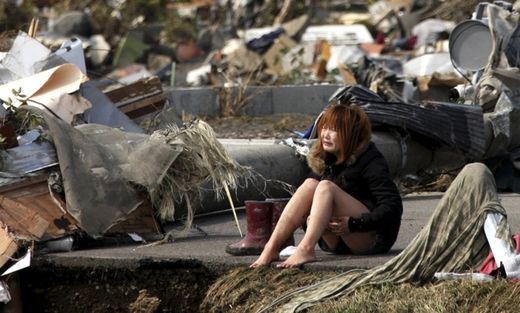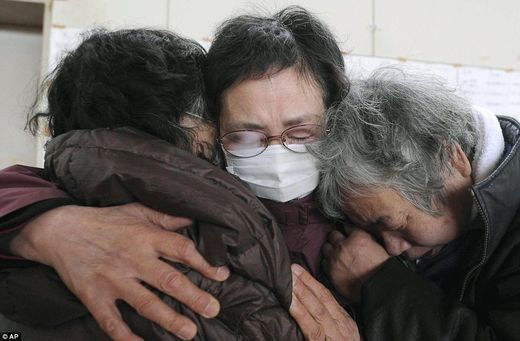
Although officials are still struggling to meet the immediate, physical needs of survivors, the psychological wounds of this disaster, for those directly impacted and the nation as a whole, will leave their imprint for years, even decades, to come, psychologists say.
Beyond the practical aspects of rebuilding, how does a devastated nation restore the minds and hearts of its people and stave off long-term psychological distress? Even as relief efforts fight to get food, baby formula, water, and oil to the affected region, post-trauma mental health care has already begun.
Psychiatric teams have gone into the area, says Dr. Makiko Okuyama, head of the Department of Psychosocial Medicine at the National Center for Child Health Development, who is part of the relief effort now in Japan.
After Japan's Kobe earthquake in 1995, "it was chaos," he says, but that disaster birthed Japan's first consolidated system for psychological aid following a crisis. "But this disaster is much more than we expected; too wide [of an] area and too much damage," he says.
Meeting physical needs is the first priority for psychological aid, he adds.
Back in Tokyo, the Japanese Society of Neurology and Psychiatry, the equivalent to the American Psychological Association, is meeting Friday night to discuss how it will handle the situation, says Dr. Fumitaka Noda, co-chair of the World Psychiatric Association and chair of the Japanese Society of Transcultural Psychiatry at Taisho University in Japan.
It will take a long and concerted effort on the part of mental health care workers in Japan, and most likely those abroad as well, to meet the psychological needs of the survivors in the coming weeks, months and years, says Reiko True, a clinical psychologist who worked with Kobe earthquake victims and was in Tokyo's Narita airport at the time of last week's earthquake.
"Since Kobe [Japan] has done a lot of preparation for dealing with "not only the physical and structural needs of a community, but to care for the psychological wounds of the people, but I think the needs now are overwhelming," she says. "Eventually, they will want and welcome help from the outside. What I'm hearing is that they are not prepared to accept mental health help from the outside yet, though."
Therapy Too Early a Danger: What Japan Will Need
Although many survivors are no doubt in psychological distress, therapy is not actually what they need at this point, psychology experts say.
"We need to be careful, the urge for mental health care providers is to rush right in and do some kind of psychological help, but data suggests that getting people too involved in talking about trauma while it's still going on is not helpful," says Joseph Scotti, professor of psychology at Eberly College of Arts and Sciences.
"You cannot help people with therapy when they are living in radiated rubble. To work on psych stuff you have to first get them safe and sheltered and their family together."
That's especially true for a culture such as Japan's, which puts a lot of emphasis on community and family. The essential role that mental health care workers can play at this point is to help people locate family members and field immediate psychological breakdowns as necessary, not force people to talk about the trauma who may still be in shock.
"Restore physical safety, that's number one, but number two is reuniting families and communities wherever possible," says Dr. Joan Anzia, associate professor of Psychiatry at Northwestern Medicine. "This is actually a form of treatment."
In the coming weeks, however, more in depth counseling will be necessary to stem the tide of post-traumatic stress disorder that psychiatrists say is inevitable after a disaster of this magnitude.
"The literature is clear that the extent and severity of PTSD and other disaster-related reactions follows a 'dose of exposure' pattern," says Alan Steinberg, associate director of the UCLA/Duke University National Center for Child Traumatic Stress, meaning that the number of traumatic events and the extent of them is directly proportionate to the extent of the "disaster after the disaster," or the psychological fallout.
"Typically, we see rates of PTSD are about a third of those affected by the trauma, but with these three traumas, earthquake, tsunami, and radiation, the rates of PTSD are likely to be incredible," Scotti adds.
From Hiroshima to Fukushima: Japan and Nuclear Anxiety
And continual psychological aid for a long period of time will be essential in Japan. These disasters have a long afterlife in terms of psychological distress, says Dr. Besser van der Kolk, professor of Psychiatry, Boston University School of Medicine.
This can be seen among victims of Hurricane Katrina, a third of whom, three years later, still suffer from PTSD. There also tends to be a "rush of help" at the beginning of a crisis such as this one, with mental health aid petering out after initial interest. So it is important to emphasize continual aid.
Although the earthquake and tsunami were colossal disasters in their own right, the subsequent and increasing nuclear threat surrounding the damaged nuclear power plant at Fukushima brings with it a different order of anxiety, anger, and fear for the Japanese people; one that may be harder to cope with than the natural disaster that spurred it, psychiatrists say.
"The distress from the nuclear threat is very different; an 'act of God' like an earthquake is different from a man-made disaster," Northwestern's Anzia says. "With a man-made disaster, there's more of a feeling of betrayal by your government, and betrayal traumas have in some ways a heavier impact."
Nuclear threat will have a special impact on the Japanese people, many of whom have grown up in the shadow of the ravages of the atomic bomb at Hiroshima and Nagasaki post-WWII.
Survivors of Hiroshima and Nagasaki faced lifelong fear of "invisible contamination" with radiation, says Robert Lifton, a psychiatrist and Hiroshima expert.
Because radiation cannot be seen or smelled, and because its damaging effects can take months or years to manifest, anxiety surrounding contamination is more subversive and harder to address than the anxiety and stress surrounding other disasters.
"The fear of radiation effects [from this disaster] will linger indefinitely, even after some improvement in the situation," he says.
Already these fears have led thousands, both foreigners and natives, to attempt to flee Japan. Trucks with aid refuse to transport supplies to areas within about an 18-mile radius of the plant, mayor of Minami Soma, a town in that region, told the Japanese broadcaster NHK. "We are being labeled as contaminated lepers," he said.
What can be done to assuage these fears?
Considering the contamination is likely to reach a large portion of Japan, "it's a very difficult situation to handle," psychiatrist Lifton says. "It would be wrong to minimize the danger, yet the actual threat ... can be terrifying."
Information about the extent of the disaster and its limitations is crucial, however, because "right now there would seem to be a combination of lack of knowledge and inclination to minimize," he says.
And lack of information only breeds confusion, panic, and anxiety.




Reader Comments
to our Newsletter